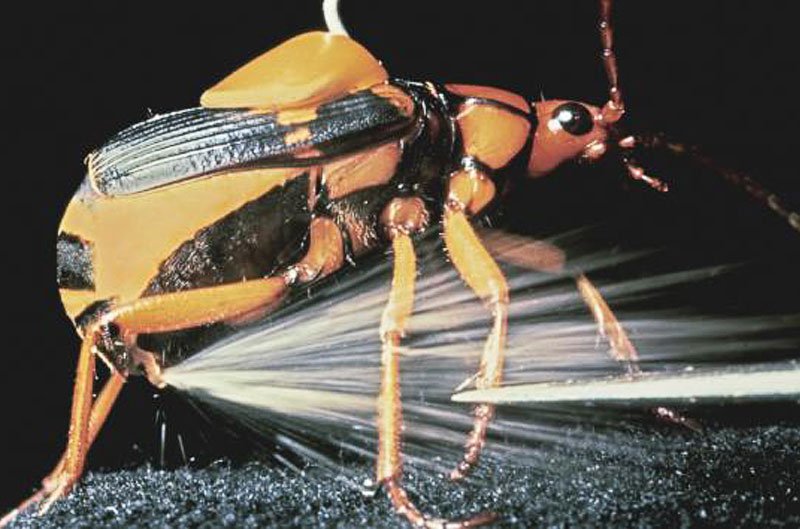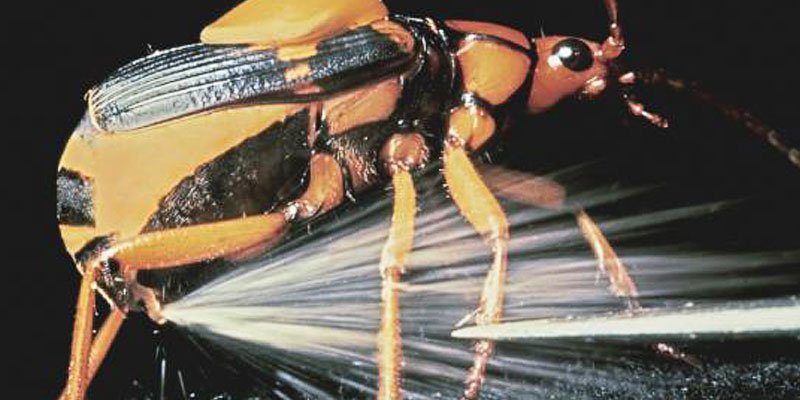
If you’ve ever marveled at the wonders of nature, the Bombardier Beetle might just blow your mind. Imagine a tiny creature that can shoot a hot, noxious chemical spray at its enemies, all while maintaining a cool demeanor. It’s like something straight out of a superhero comic! These beetles have a unique defense mechanism that allows them to stand firm against predators, and understanding how they do it is a fascinating journey.
The Bombardier Beetle belongs to the family Carabidae, which is rich with over 350 species. Found in various environments—from forest floors to arid deserts—these beetles are adaptable and resilient. Often, they can be spotted scuttling across the ground, showcasing their dark, glossy exoskeletons that speak of their durability. But what makes them truly special isn’t just their looks; it’s their remarkable ability to defend themselves, a skill that has fascinated scientists and nature lovers alike.
What Makes the Bombardier Beetle Unique?
The Bombardier Beetle’s most incredible feature is its ability to spray a hot, corrosive chemical at predators. But how does it create this explosive defense? It all boils down to a special reaction between two chemicals: hydrogen peroxide and hydroquinone. These substances are stored separately in specialized glands and mix together when the beetle feels threatened. The result? A jet of boiling, toxic liquid that can reach temperatures of around 100 degrees Celsius!
This fascinating defense mechanism doesn’t just deter predators; it can actually injure or even kill them. Imagine being chased by a foe that not only bites but also sprays hot liquid at you! That’s a pretty effective way to keep potential predators like frogs and birds at bay. Interestingly, the Bombardier Beetle can control the direction and intensity of its spray, allowing it to accurately target its attacker, much like a tiny superhero aiming a powerful gadget.
Physical Characteristics
Bombardier Beetles come in various shapes, sizes, and colors, but most share a few common physical traits. Typically, they are small to medium-sized beetles, measuring about 1 to 2 centimeters in length. Their bodies are generally elongated and oval-shaped, often exhibiting a dark, shiny external layer. This hard shell not only serves as a protective barrier but also adds to their striking appearance.
The legs of these beetles are quite strong, adapted for quick movement. They can swiftly scurry away if needed, making it harder for predators to catch them. Interestingly, their eyes are large and multifaceted, providing them with a broad field of vision, which is crucial for spotting threats in their environment. In terms of coloration, while many Bombardier Beetles are black or brown, some species display beautiful metallic hues that can shimmer in the light, adding to their allure.
Habitat and Distribution
Bombardier Beetles are quite versatile when it comes to their habitats. They can be found in various locales, including temperate forests, grasslands, and even some urban areas. This adaptability allows them to thrive in different conditions as long as they have access to food and shelter. More than just surviving, these beetles play a crucial role in their ecosystems, often helping in pest control.
In terms of geographic distribution, you can find Bombardier Beetles all over the world! They inhabit regions on every continent except Antarctica. From the lush forests of North America to the dry deserts of Australia, their ability to thrive in diverse environments is nothing short of impressive. This adaptability has allowed them to evolve unique traits and behaviors suited to their specific habitats.
Diet and Feeding Habits
When it comes to food, Bombardier Beetles are primarily carnivorous. They mainly feed on other insects, which makes them valuable players in controlling pest populations. Their diet can include aphids, caterpillars, and even other beetles. This predatory nature allows them to keep the balance in their ecosystems, benefiting the plants and other creatures around them.
Interestingly, these beetles employ a strategy called “ambush predation.” They often lie in wait for their unsuspecting prey, ready to spring into action. Once they spot a target, they can go for the kill swiftly, using their strong mandibles to capture and consume their meal. What’s more, their powerful jaws allow them to tackle larger insects, showcasing their impressive hunting skills!
Reproduction and Life Cycle
The life cycle of the Bombardier Beetle is just as fascinating as its defensive mechanisms. After mating, the female lays eggs in soil or decaying plant matter, providing a safe environment for her offspring. Once the eggs hatch, the larvae emerge, looking quite different from their adult counterparts. These larvae are typically worm-like and spend their early stages feeding on organic matter, which helps them grow strong.
As they mature, the larvae will undergo several molts before finally pupating. This stage is crucial as it allows them to transform into adults. The pupal stage can last several weeks, during which time the insect develops its final form. Eventually, they emerge as fully developed Bombardier Beetles, ready to start the cycle again. This fascinating transformation process, known as complete metamorphosis, is common in beetles and adds another layer of intrigue to their story.
Defense Mechanism in Detail
As mentioned earlier, the Bombardier Beetle’s ability to spray a hot chemical is one of its most remarkable traits. When threatened, the beetle can release a mix of chemicals from its abdomen. This process is highly sophisticated; they have special valves that allow them to control the mixture’s release, ensuring maximum effectiveness.
The chemicals involved in this defensive spray—hydrogen peroxide and hydroquinone—are stored separately and only mixed when needed. This clever design prevents any premature reactions. When combined in the reaction chamber, they are catalyzed by certain enzymes, leading to the explosive ejection of the hot liquid. Not only does this act as a defense, but the boiling spray can also create a loud popping noise, further startling potential predators.
In the wild, different species of Bombardier Beetles might use varying concentrations of these chemicals, depending on their specific threats. Some can even create a thick, toxic cloud if they feel particularly endangered. This unique ability is not just fascinating but also serves as a testament to the incredible adaptability of nature, highlighting how even the smallest creatures have evolved remarkable survival strategies.
Conservation Status
Although many Bombardier Beetle species are not currently endangered, monitoring their populations is essential. Habitat loss due to urbanization and agriculture can pose threats to their survival. Much like other insects, they serve crucial ecological roles that support biodiversity, so their decline can have wider implications.
Efforts to conserve their habitats and encourage biodiversity are vital. Creating awareness about these unique beetles can foster appreciation and understanding of their importance in ecosystems. By protecting the environments they rely on—like forests and grasslands—we can help ensure their survival for generations to come. Simple actions, like planting native plants in your garden, can aid in providing stable habitats for various insect species, including the Bombardier Beetle.
Interesting Facts About Bombardier Beetles
| Size: | 1 to 2 centimeters |
| Habitat: | Forests, grasslands, urban areas worldwide |
| Diet: | Carnivorous; primarily other insects |
| Lifespan: | 1 to 2 years |
| Color: | Predominantly black or brown, with some metallic species |
FAQ
Are Bombardier Beetles dangerous to humans?
Not at all! While Bombardier Beetles have a unique defense mechanism that allows them to spray hot chemicals, they pose no threat to humans. The spray is designed to deter predators, like birds and frogs, and is not harmful to larger animals. If you happen to encounter one, just admire its fascinating abilities from a distance!
How do Bombardier Beetles spray their chemical defense?
The beetles have specialized glands that store two separate chemicals: hydrogen peroxide and hydroquinone. When threatened, they mix these chemicals in a reaction chamber within their body. This mixture creates a rapid reaction that generates hot gas, forcing the boiling liquid out as a spray. This process is highly controlled, allowing them to aim accurately at their attackers.
What do Bombardier Beetles eat?
These beetles are primarily carnivorous and enjoy feeding on a variety of insects, such as aphids and caterpillars. Their predatory nature helps control pest populations, making them beneficial for ecosystems. Hidden in their habitat, they often ambush their prey, showcasing their skill as hunters.
Where can I find Bombardier Beetles?
You can find Bombardier Beetles in diverse environments across the globe, from forests to grasslands, and even urban areas. They adapt well to their surroundings, so keep an eye out for them in gardens or parks. You might spot them crawling on the ground or hiding under leaves!
How long do Bombardier Beetles live?
Typically, Bombardier Beetles have a lifespan of about 1 to 2 years. However, their life cycle can be influenced by environmental factors, such as food availability and habitat conditions. During this time, they undergo complete metamorphosis, transforming from larvae to adults.
Are all Bombardier Beetles the same color?
No, Bombardier Beetles exhibit a range of colors and patterns. While many are black or dark brown, some species are adorned with beautiful metallic hues. Coloration can play a role in camouflage or attracting mates, showcasing the diversity within their family.
Can Bombardier Beetles be pets?
While it’s possible to keep them in a controlled environment, Bombardier Beetles are not common pets. They thrive best in their natural habitats, where they have access to food and mates. If you’re interested in observing them, consider creating a garden that attracts various beetles and insects, allowing you to enjoy their fascinating behavior.
Do Bombardier Beetles have any natural predators?
Yes, even Bombardier Beetles, with their unique defense mechanisms, have natural enemies. Predators such as birds, frogs, and larger insects might attempt to prey on them. However, their ability to spray a hot, noxious liquid helps them evade these potential threats effectively.
What role do Bombardier Beetles play in their ecosystem?
Bombardier Beetles play an important role in their ecosystems as predators. By feeding on various insects, they help maintain a balance in populations, which can be beneficial for plants and other species. Their presence also indicates a healthy environment, contributing to overall biodiversity.
Why are Bombardier Beetles important to study?
Studying Bombardier Beetles offers insights into evolutionary adaptations and chemical defense mechanisms in nature. Their unique method of defense can inspire biomimicry in science and technology, providing ideas for new materials and processes. Understanding them better can also aid in conservation efforts, highlighting the importance of protecting diverse insect species.

